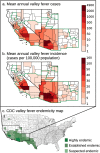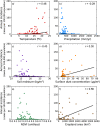Coccidioidomycosis Dynamics in Relation to Climate in the Southwestern United States
- PMID: 32158997
- PMCID: PMC7007142
- DOI: 10.1002/2017GH000095
Coccidioidomycosis Dynamics in Relation to Climate in the Southwestern United States
Abstract
Valley fever is endemic to the southwestern United States. Humans contract this fungal disease by inhaling spores of Coccidioides spp. Changes in the environment can influence the abundance and dispersal of Coccidioides spp., causing fluctuations in valley fever incidence. We combined county-level case records from state health agencies to create a regional valley fever database for the southwestern United States, including Arizona, California, Nevada, New Mexico, and Utah. We used this data set to explore how environmental factors influenced the spatial pattern and temporal dynamics of valley fever incidence during 2000-2015. We compiled climate and environmental geospatial data sets from multiple sources to compare with valley fever incidence. These variables included air temperature, precipitation, soil moisture, surface dust concentration, normalized difference vegetation index, and cropland area. We found that valley fever incidence was greater in areas with warmer air temperatures and drier soils. The mean annual cycle of incidence varied throughout the southwestern United States and peaked following periods of low precipitation and soil moisture. From year-to-year, however, autumn incidence was higher following cooler, wetter, and productive springs in the San Joaquin Valley of California. In southcentral Arizona, incidence increased significantly through time. By 2015, incidence in this region was more than double the rate in the San Joaquin Valley. Our analysis provides a framework for interpreting the influence of climate change on valley fever incidence dynamics. Our results may allow the U.S. Centers for Disease Control and Prevention to improve their estimates of the spatial pattern and intensity of valley fever endemicity.
Keywords: climate; coccidioides; coccidioidomycosis; incidence/epidemiology; mycoses; surveillance/epidemiology.
©2017. The Authors.
Conflict of interest statement
The authors declare no conflicts of interest relevant to this study.
Figures








References
-
- Arizona Department of Health Services (2012). Arizona—Valley fever report, 2007–2011. Arizona Department of Health Services. Phoenix, AZ. Retrieved from http://vfce.arizona.edu/sites/vfce/files/5-year-review-07-11.pdf
-
- Arizona Department of Health Services (2013). Valley fever 2012 annual report. Arizona Department of Health Services. Phoenix, AZ. Retrieved from http://www.azdhs.gov/documents/preparedness/epidemiology-disease-control...
-
- Baptista‐Rosas, R. C. , Catalán‐Dibene, J. , Romero‐Olivares, A. L. , Hinojosa, A. , Cavazos, T. , & Riquelme, M. (2012). Molecular detection of Coccidioides spp. from environmental samples in Baja California: Linking valley fever to soil and climate conditions. Fungal Ecology, 5(2), 177–190. 10.1016/j.funeco.2011.08.004 - DOI
-
- Barker, B. M. , Tabor, J. A. , Shubitz, L. F. , Perrill, R. , & Orbach, M. J. (2012). Detection and phylogenetic analysis of Coccidioides posadasii in Arizona soil samples. Fungal Ecology, 5(2), 163–176. 10.1016/j.funeco.2011.07.010 - DOI
LinkOut - more resources
Full Text Sources
Miscellaneous
